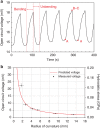Electrochemically driven mechanical energy harvesting
- PMID: 26733282
- PMCID: PMC4729818
- DOI: 10.1038/ncomms10146
Electrochemically driven mechanical energy harvesting
Abstract
Efficient mechanical energy harvesters enable various wearable devices and auxiliary energy supply. Here we report a novel class of mechanical energy harvesters via stress-voltage coupling in electrochemically alloyed electrodes. The device consists of two identical Li-alloyed Si as electrodes, separated by electrolyte-soaked polymer membranes. Bending-induced asymmetric stresses generate chemical potential difference, driving lithium ion flux from the compressed to the tensed electrode to generate electrical current. Removing the bending reverses ion flux and electrical current. Our thermodynamic analysis reveals that the ideal energy-harvesting efficiency of this device is dictated by the Poisson's ratio of the electrodes. For the thin-film-based energy harvester used in this study, the device has achieved a generating capacity of 15%. The device demonstrates a practical use of stress-composition-voltage coupling in electrochemically active alloys to harvest low-grade mechanical energies from various low-frequency motions, such as everyday human activities.
Figures





References
-
- Xu S. et al.. Self-powered nanowire devices. Nat. Nanotechnol. 5, 366–373 (2010). - PubMed
-
- Snyder G. J. & Toberer E. S. Complex thermoelectric materials. Nat. Mater. 7, 105–114 (2008). - PubMed
-
- Priya S. & Inman D. Energy Harvesting Technologies Springer US (2009).
-
- Beeby S. P., Tudor M. J. & White N. M. Energy harvesting vibration sources for microsystems applications. Meas. Sci. Technol. 17, R175–R195 (2006).
-
- Ravindran S. K. T., Huesgen T., Kroener M. & Woias P. A self-sustaining micro thermomechanic-pyroelectric generator. Appl. Phys. Lett. 99, 104102 (2011).
Publication types
MeSH terms
Substances
LinkOut - more resources
Full Text Sources
Other Literature Sources
Molecular Biology Databases

